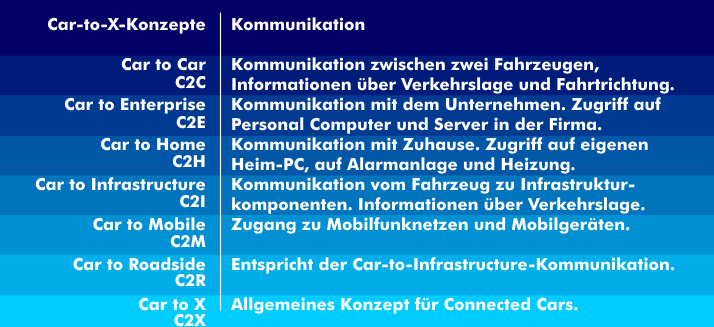car to car communication (C2C)
Car-to-car communication(C2C) - in English the term vehicle-to-vehicle communication (V2V) is common - is the direct exchange of information between moving vehicles. With this mobile communication, functional radio networks and new applications can be realized. These include timely information about road and traffic conditions such as black ice, aquaplaning, accidents or stalled vehicles. In this safety-relevant application, the corresponding road user sends the indication of the danger location with the data from the navigation system.
Further information concerning the traffic flow is information about traffic light phases, stop-and-go driving or constant starting and stopping at road works etc.. The search for a parking space or information about available parking spaces can also be included in such vehicle-to-vehicle communication.
In car-to-car communication, standardized messages are exchanged between cars via the air interface. The messages about the current traffic situation are managed in the ITS stations of the Cooperative Intelligent Transport System( C-ITS) and sent cyclically or event-driven. There are the Cooperative Awareness Message( CAM), the Decentralized Environmental Notification( DEN), SignalPhase and Timing (SPAT) and the Topology Specification( TO- PO).
The frequency range and transmission power
The European Union has released the microwave range between 5.875 GHz and 5.905 GHz for C2C applications, and car-to-car communication uses the radio technology ofWLANs according to 802.11p. The transmission power( EIRP) is set at 23 dBm/ MHz, and must not exceed 33 dBm. The radio telegrams sent out by a vehicle contain the vehicle position determined by the GPS system together with time and speed information; in addition, the area in which other vehicles must be warned is defined and the event is transmitted in code. For example, driving at walking pace or stationary traffic or abrupt braking.
The vehicles receiving the radio telegrams work as repeaters and spread the message further, increasing the information space. How far the message is spread depends on the relevance zone, which is the area that is relevant to the event. In the case of a short braking event, the relevance zone is of course much smaller than in the case of an indication of a traffic jam. This zone of relevance is dictated by the transmitting vehicle, which results in the dissemination via the repeater vehicles to include a smaller or larger area.
Conceptually, communication via Roadside Units( RSU) or Intelligent Roadside Station( IRS) interconnected via Access Routers( AR) is also envisioned. C2C networks that communicate via these components are Wireless Access for Vehicular Environment(WAVE) and Vehicular Ad-Hoc Networks( VANET).
C2C and V2V are combined in the subject area V2X, Vehicle to Everything.


_en.png)